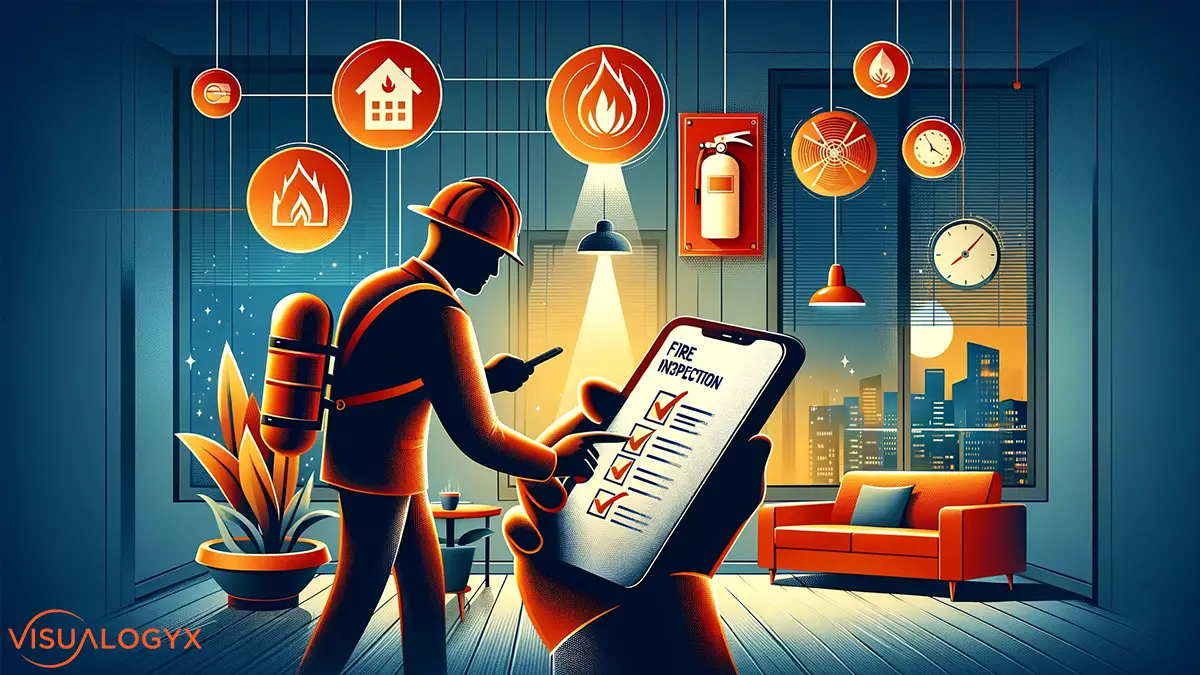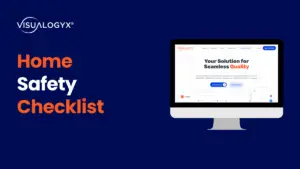Introduction
The significance of fire safety and the regular execution of fire inspections cannot be overstated in the context of safeguarding human life and property assets. Fires, by their nature, are unpredictable and can escalate rapidly, leading to devastating consequences. Thus, it is imperative that individuals and organizations prioritize preventive measures and readiness to mitigate such risks.
The importance of systematic fire safety inspections extends beyond mere adherence to regulatory requirements; it is fundamentally about the protection of lives and investments. Regular inspections serve as a crucial mechanism in identifying and rectifying potential hazards before they manifest into severe incidents. Despite this, the complexity and breadth of what constitutes a thorough fire safety inspection can be daunting to many.
This blog post is intended to clarify and streamline the process of fire safety evaluations, providing a detailed checklist suited for both residential settings and professional environments. It is designed to guide homeowners, business operators, and safety enthusiasts through the essential components and considerations of fire safety, from general precautions to the maintenance of specialized equipment.
By engaging with this comprehensive guide, readers will acquire the necessary insights and tools to conduct effective fire safety inspections. The objective is to foster a more informed and vigilant approach to fire prevention, contributing to safer living and working spaces. Let us delve into the critical aspects of fire safety inspections, with a focus on preventative strategies and best practices.
Understanding Fire Safety Inspections
When it comes to ensuring the safety of your home or workplace, understanding the scope and importance of fire safety inspections is paramount. This initial section of our blog will guide you through what fire safety inspections entail, their objectives, and the general legal frameworks that govern them.
What is a Fire Safety Inspection?
A fire safety inspection is a thorough examination of your premises to identify potential fire hazards and ensure that all fire prevention and safety measures are up to current standards. It involves checking the condition and adequacy of fire safety equipment, ensuring that fire escape routes are accessible and clear, and verifying that the property complies with fire safety codes and regulations. The aim is to minimize the risk of fire, thereby protecting lives and property.
Incorporating a comprehensive “fire safety inspection checklist” into these evaluations ensures no stone is left unturned. This checklist typically includes items such as:
- Checking smoke detectors and fire alarm systems
- Inspecting fire extinguishers and other firefighting equipment
- Evaluating the condition and accessibility of fire exits
- Assessing the storage and handling of flammable materials
Sign up with Visualogyx and download a free Fire Safety Inspection Checklist template from our Public Templates library.
Objectives of Conducting Fire Safety Inspections
The primary objectives of conducting fire safety inspections are:
- Preventing Fires:
Identifying and mitigating potential fire hazards to prevent fire outbreaks.
- Ensuring Safety:
Ensuring that, in the event of a fire, there are adequate measures in place to protect people and property.
- Compliance:
Ensuring that buildings and businesses comply with local, state, and federal fire safety codes and regulations.
- Education:
Educating property owners, employees, and the public on fire risks and prevention measures.
Legal Requirements and Standards for Fire Safety
While specific legal requirements for fire safety inspections can vary depending on your location, there are general standards that most regions adhere to. These typically include:
- Regular Inspections:
Mandating regular fire safety inspections for all commercial and residential buildings.
- Compliance with Codes:
Requiring that all buildings comply with the local fire code, which may be based on national standards such as the National Fire Protection Association (NFPA) codes.
- Installation and Maintenance of Fire Safety Equipment:
Ensuring that fire detection, alarm, and suppression systems are installed and maintained according to the prescribed standards.
- Access and Egress:
Maintaining clear paths to emergency exits and ensuring that fire escape routes are clearly marked and unobstructed.
It’s crucial for property owners and managers to familiarize themselves with the specific laws and regulations applicable in their area to ensure full compliance and safety.
By understanding what fire safety inspections encompass, their objectives, and the legal standards required, you are better equipped to ensure that your property is safe and compliant. This not only protects those who use the space but can also significantly reduce the risk of devastating fire-related incidents.
Preparing for a Fire Safety Inspection
Proper preparation can significantly streamline the fire safety inspection process and ensure that your premises meet all necessary safety standards. This section outlines the steps you should take before the inspection, the documents and equipment you need to gather, and the common areas of concern that you should address.
Steps to Take Before the Inspection
To adequately prepare for a fire safety inspection, consider the following steps:
- Review Previous Inspection Reports:
If your property has been inspected before, review the last report to address any previously identified issues.
- Conduct a Preliminary Self-Inspection:
Using a fire safety inspection checklist, walk through your premises to identify and rectify potential hazards.
- Educate Your Staff:
Ensure that all employees are aware of fire safety procedures and understand their roles in maintaining a safe environment.
- Schedule Repairs:
If you find any malfunctioning safety equipment or other issues, schedule repairs before the inspection date.
- Document Actions Taken:
Keep a record of all the steps you’ve taken to address fire safety issues, including repairs and staff training sessions.
Gathering Necessary Documents and Equipment
Being well-prepared involves having all necessary documents and equipment readily available for the inspector. Ensure you have the following on hand:
- Evacuation Plans:
Updated and clearly displayed plans showing all exits and fire equipment locations. - Maintenance Records:
Documentation showing regular maintenance and testing of fire alarms, extinguishers, sprinklers, and other safety equipment. - Staff Training Records:
Proof of fire safety training sessions attended by employees. - Compliance Certificates:
Any certificates or documents proving compliance with local fire safety standards.
Identifying Common Areas of Concern
Certain areas and elements tend to be focal points during fire safety inspections. Pay particular attention to:
- Fire Exits and Escape Routes:
Ensure they are clearly marked, well-lit, and unobstructed. - Fire Alarm and Sprinkler Systems:
Check that they are functional and have been inspected and tested according to schedule. - Electrical Systems:
Look for overloaded outlets, frayed wires, and improper use of extension cords. - Storage Areas:
Ensure flammable materials are stored properly and are away from ignition sources. - Fire Extinguishers:
Verify that they are in the correct location, easily accessible, and have been inspected within the last year.
By thoroughly preparing for a fire safety inspection, you can ensure that your premises not only pass the inspection but also provide a safe environment for everyone. Remember, the goal of these inspections is not just to comply with regulations but to minimize the risk of fire, protecting both lives and property.
Fire Safety Inspection Checklist
This comprehensive checklist is designed to help homeowners and workplace managers conduct thorough fire safety inspections. Use this as a guide to identify and rectify potential fire hazards in your environment.
Sign up with Visualogyx and download a free Fire Safety Inspection Checklist template from our Public Templates library.
General Safety Measures
Smoke Alarms:
- Installed on every level of the home/workplace, inside each bedroom, and outside sleeping areas.
- Tested monthly and batteries replaced annually (if not hardwired).
- Free from dust and obstructions.
Carbon Monoxide Detectors:
- Installed according to manufacturer’s instructions and local regulations.
- Tested regularly and batteries replaced as needed.
Fire Escape Plans:
- A clear escape plan is in place and known by all occupants.
- Practice fire drills at least twice a year.
- Escape routes are clear and free of obstructions.
Fire Doors:
- Close properly and are not propped open.
- Seals and latches are in good condition.
Fire Detection and Alarm Systems
Maintenance Records:
- Up-to-date records of all fire safety system inspections and maintenance.
Alarm Systems:
- Properly installed and functioning.
- Audible throughout the entire premises.
Fire Extinguishers and Firefighting Equipment
Location and Accessibility:
- Adequately distributed throughout the premises and in known locations.
- Accessible without obstruction.
Inspection Tags:
- Checked monthly for physical damage.
- Inspected professionally once a year and tagged.
Training:
- Occupants are trained in the correct use of fire extinguishers.
Electrical Safety
Outlets and Cords:
- No overloaded electrical outlets or extension cords.
- Cords are in good condition without fraying or exposed wires.
Electrical Panels:
- Accessible with a clear area of at least 36 inches in front.
- Labels are clear and circuits are not overloaded.
Appliances:
- Properly maintained and free of visible damage.
- Kept away from combustible materials.
- Hazardous Materials
Storage:
- Flammable liquids are stored in approved, clearly labeled containers.
- Kept away from sources of heat and ignition.
Disposal:
- Hazardous waste is disposed of safely and according to local regulations.
- Training and Awareness
Fire Safety Training:
- Regular training sessions conducted for all occupants.
- Special training for the use of fire-fighting equipment.
Signage:
- Fire action notices and evacuation routes are displayed prominently.
- Emergency numbers are posted and easily visible.
Special Considerations for Workplaces
Emergency Lighting:
- Functioning correctly and adequately illuminates escape routes.
Signage and Wayfinding:
- Exit signs are illuminated and clearly visible.
- Fire equipment signs are present and unobstructed.
First Aid:
- Adequate first aid supplies are available and accessible.
- Employees are trained in basic first aid.
Post-Inspection Follow-Up
After a thorough fire safety inspection, understanding and acting upon the findings is crucial for maintaining a safe environment. This section covers how to interpret inspection reports, prioritize corrective actions, and ensure ongoing compliance through scheduled inspections and record-keeping.
Understanding Inspection Reports
When you receive the inspection report, it will detail all the findings from the fire safety inspection, including compliant areas and those needing attention. Here’s how to approach this document:
- Review All Findings:
Carefully read through the report to understand the inspector’s observations and recommendations. - Clarify Doubts:
If any part of the report is unclear, don’t hesitate to contact the inspector for clarification. It’s important that you fully understand all the issues noted. - Document Review:
Keep a record of the report and any communications with fire safety officials for future reference.
Prioritizing and Addressing Identified Issues
Once you fully understand the inspection report, the next step is to address the identified issues:
- Prioritize Issues:
Sort the issues based on their impact on safety. Address high-risk problems, such as malfunctioning fire alarms or blocked exits, as a matter of urgency. - Develop a Corrective Action Plan:
For each issue, outline the steps needed to correct it, assign responsibility, and set a deadline. - Implement Solutions:
Act on the plan, making the necessary repairs or adjustments. Hire qualified professionals if the fixes are beyond your expertise. - Verification:
After corrective actions have been taken, verify that they meet the required safety standards. You may need to schedule a follow-up inspection for official verification.
Scheduling Next Inspections and Maintaining Records
Staying ahead with regular inspections and maintaining an organized record are key to continuous fire safety:
- Schedule Next Inspections:
Don’t wait for regulatory prompts; schedule your next fire safety inspection based on the recommended intervals or sooner if significant changes occur in your environment. - Maintain Records:
Keep a detailed log of all inspections, repairs, and maintenance actions. Include dates, notes, and receipts. These records can be crucial for insurance purposes, legal compliance, and future safety audits. - Continuous Improvement:
Use the insights gained from each inspection to improve your fire safety practices. Regularly update your fire safety inspection checklist and emergency plans based on new findings or changes in regulations.
Tips for Maintaining Ongoing Fire Safety
By thoroughly understanding your inspection report, addressing issues with a sense of urgency, and maintaining a cycle of continuous improvement, you can ensure that your premises remain safe and compliant. Remember, fire safety is an ongoing commitment, and post-inspection follow-up plays a critical role in protecting lives and property.
Maintaining ongoing fire safety requires continuous commitment and a proactive approach to identify and mitigate potential hazards. Conduct regular self-assessments using a comprehensive fire safety inspection checklist to ensure all areas of concern are continuously monitored and addressed. It is crucial to regularly test and maintain fire detection systems, alarms, and firefighting equipment. This includes checking smoke detectors monthly and ensuring fire extinguishers are accessible, properly charged, and within their inspection dates.
Educate and train all occupants, whether they are family members or employees, about fire safety procedures, evacuation plans, and the correct use of firefighting equipment. Implement a clear communication strategy that includes prominently displaying emergency exits, evacuation routes, and procedures around the home or workplace. Additionally, it’s vital to keep all areas free from clutter, especially near exits and fire equipment, to ensure a quick and unobstructed evacuation during emergencies. Regularly review and update your fire safety policies and procedures to reflect any changes in the living or working environment and engage with local fire services for expert advice and training opportunities. By integrating these practices into your daily routine and organizational culture, you can foster an environment that prioritizes safety and reduces the risk of fire-related incidents.
Conclusion
In conclusion, the importance of regular fire safety inspections cannot be overstressed. They are essential for identifying potential hazards, ensuring the effectiveness of safety measures, and maintaining compliance with legal standards. Fire safety is a continuous process, not a one-time event, and it requires the participation and vigilance of everyone involved, from homeowners to workplace managers. By adhering to a comprehensive fire safety inspection checklist, you can significantly reduce the risk of fire incidents and ensure a safer environment for everyone.
However, understanding and implementing these safety measures is just the beginning. It is up to you to take proactive steps towards maintaining and enhancing fire safety in your surroundings. Remember, the actions you take today can prevent potentially devastating incidents tomorrow. Do not wait for a fire incident to occur before appreciating the value of fire safety inspections. Take the initiative to regularly review, update, and practice your fire safety procedures.








